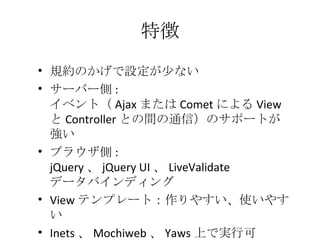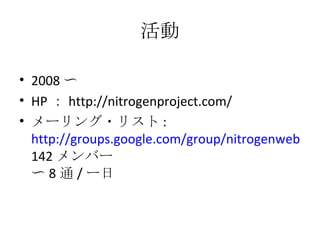Nitrogen Web Framework
Download as PPT, PDF0 likes2,216 views
Introduction about Nitrogen Web Framework
1 of 10
Downloaded 10 times










Ad
Recommended
第1回 CMS Fun Nagoya - Movable Typeの紹介-



第1回 CMS Fun Nagoya - Movable Typeの紹介-新一 佐藤 様々な CMSを横断して学ぶ勉強会、CMS Fun Nagoyaの第1回でMovable Typeの紹介を発表しました。
[MR03] HoloLens - 真のエンジニアが知るべき実装![[MR03] HoloLens - 真のエンジニアが知るべき実装](https://cdn.slidesharecdn.com/ss_thumbnails/mr03-170616020209-thumbnail.jpg?width=560&fit=bounds)
![[MR03] HoloLens - 真のエンジニアが知るべき実装](https://cdn.slidesharecdn.com/ss_thumbnails/mr03-170616020209-thumbnail.jpg?width=560&fit=bounds)
![[MR03] HoloLens - 真のエンジニアが知るべき実装](https://cdn.slidesharecdn.com/ss_thumbnails/mr03-170616020209-thumbnail.jpg?width=560&fit=bounds)
![[MR03] HoloLens - 真のエンジニアが知るべき実装](https://cdn.slidesharecdn.com/ss_thumbnails/mr03-170616020209-thumbnail.jpg?width=560&fit=bounds)
[MR03] HoloLens - 真のエンジニアが知るべき実装de:code 2017 優れたミドルウェアのおかげで HoloLens アプリの開発は難しくありません。誰でも簡単に、プログラムが書けなくても作ることができます。しかしそこに依存するあなたは自分をエンジニアと胸を張っていえますか。本セッションでは DirectX やその他の比較的低いレイヤーを用いた開発例をご覧いただきながら、特徴ある Mixed Reality の各種設計で注意すべきことを理解する真のエンジニアになっていただきます。
製品/テクノロジ: HoloLens/Windows Mixed Reality
千葉 慎二
日本マイクロソフト株式会社
デベロッパー エバンジェリズム統括本部
エバンジェリスト
Cloud Erlang



Cloud ErlangNgoc Dao You normally think of virtualization as virtualization at the operating system level. But with Erlang, you can do virtualization at application level.
Camellia General



Camellia GeneralNgoc Dao This document provides a general overview of the Camellia project from November 2003. It discusses smart cameras and their applications, as well as the motivations and goals of the Camellia project, which aims to develop algorithms and an architecture for a co-processor to enable smart camera functionality. The document outlines the project's applications, co-processor requirements, prototyping efforts, and conclusions.
マイクロソフトにとってのWebって?



マイクロソフトにとってのWebって?Microsoft 第三回ブラウザー勉強会で使用したスライド
http://bws.hebikuzure.com/
Kilimanjaro Event



Kilimanjaro Eventdynamis OSC Nagoya で使用したスライド
http://www.ospn.jp/osc2012-nagoya/
Edge と IE、来年からの Web 制作



Edge と IE、来年からの Web 制作Osamu Monoe Windows 10 に搭載される 2 つの Web ブラウザーと、レガシーIEのサポート終了後の来年からの Web 制作で不必要になる作業を説明します。
jQuery と MVC で実践する標準志向 Web 開発



jQuery と MVC で実践する標準志向 Web 開発Akira Inoue Presentation for OSC 2010 in Hokkaido.
http://www.ospn.jp/osc2010-do/
[AC11] サーバー管理よ、サヨウナラ。サーバーレスアーキテクチャの意義と実践![[AC11] サーバー管理よ、サヨウナラ。サーバーレスアーキテクチャの意義と実践](https://cdn.slidesharecdn.com/ss_thumbnails/ac11-170602094618-thumbnail.jpg?width=560&fit=bounds)
![[AC11] サーバー管理よ、サヨウナラ。サーバーレスアーキテクチャの意義と実践](https://cdn.slidesharecdn.com/ss_thumbnails/ac11-170602094618-thumbnail.jpg?width=560&fit=bounds)
![[AC11] サーバー管理よ、サヨウナラ。サーバーレスアーキテクチャの意義と実践](https://cdn.slidesharecdn.com/ss_thumbnails/ac11-170602094618-thumbnail.jpg?width=560&fit=bounds)
![[AC11] サーバー管理よ、サヨウナラ。サーバーレスアーキテクチャの意義と実践](https://cdn.slidesharecdn.com/ss_thumbnails/ac11-170602094618-thumbnail.jpg?width=560&fit=bounds)
[AC11] サーバー管理よ、サヨウナラ。サーバーレスアーキテクチャの意義と実践de:code 2017 サーバーレス アーキテクチャの 5 つの適用パターンを紹介し、Azure を使ったそれぞれの実装方法やデモをお見せします。設計パターンから、その実装方法までウォーク スルーすることで、サーバーレスを効果的に使うポイントを理解し、今すぐ自分でも試してみることができるようになります。
久森 達郎
日本マイクロソフト株式会社
デベロッパー エバンジェリズム統括本部
エバンジェリスト
吉田 真吾
株式会社セクションナイン
代表取締役社長
jQuery/Html5/ASP.NET MVC 対応コンポーネントを用いたデバイス対応業務アプリケーション開発



jQuery/Html5/ASP.NET MVC 対応コンポーネントを用いたデバイス対応業務アプリケーション開発Daizen Ikehara 2012/11/16 のセミナーで使用した Ignite UI スライドです
.NET Core 3.0 で Blazor を使用したフルスタック C# Web アプリの構築



.NET Core 3.0 で Blazor を使用したフルスタック C# Web アプリの構築Joni .NET Conf 2019 資料
「.NET Core 3.0 で Blazor を使用したフルスタック C# Web アプリの構築」
WindowsAzureの長所を活かすクラウド アプリ開発(PDF版)



WindowsAzureの長所を活かすクラウド アプリ開発(PDF版)Shinichiro Isago Microsoft Visualization summit 2010 の講演資料です。PPTXの変換作業が遅いので、PDF版もアップしておきます
Model with actors and implement with Akka



Model with actors and implement with AkkaNgoc Dao This document provides an overview of actor modeling and how to implement actors using the Akka library. It begins with explaining the actor model and benefits of actors over threads. It then discusses how to create actors with Akka, demonstrating with a multiplayer chess game. The schedule outlines explaining the actor model for 1/4 of the time and how to create Akka actors for 3/4 of the time using the chess game demo. Useful links are provided for Akka documentation and chess/game related projects.
I18nize Scala programs à la gettext



I18nize Scala programs à la gettextNgoc Dao This document discusses internationalizing (i18n) Scala programs using the gettext approach. It describes marking strings for translation, extracting them to template files, loading translation files, and translating at runtime. Tools are introduced for extracting strings from Scala code and templates, editing translation files, and parsing loaded files. The approach works for various Scala template engines and frameworks like Play.
Ad
More Related Content
Similar to Nitrogen Web Framework (20)
マイクロソフトにとってのWebって?



マイクロソフトにとってのWebって?Microsoft 第三回ブラウザー勉強会で使用したスライド
http://bws.hebikuzure.com/
Kilimanjaro Event



Kilimanjaro Eventdynamis OSC Nagoya で使用したスライド
http://www.ospn.jp/osc2012-nagoya/
Edge と IE、来年からの Web 制作



Edge と IE、来年からの Web 制作Osamu Monoe Windows 10 に搭載される 2 つの Web ブラウザーと、レガシーIEのサポート終了後の来年からの Web 制作で不必要になる作業を説明します。
jQuery と MVC で実践する標準志向 Web 開発



jQuery と MVC で実践する標準志向 Web 開発Akira Inoue Presentation for OSC 2010 in Hokkaido.
http://www.ospn.jp/osc2010-do/
[AC11] サーバー管理よ、サヨウナラ。サーバーレスアーキテクチャの意義と実践![[AC11] サーバー管理よ、サヨウナラ。サーバーレスアーキテクチャの意義と実践](https://cdn.slidesharecdn.com/ss_thumbnails/ac11-170602094618-thumbnail.jpg?width=560&fit=bounds)
![[AC11] サーバー管理よ、サヨウナラ。サーバーレスアーキテクチャの意義と実践](https://cdn.slidesharecdn.com/ss_thumbnails/ac11-170602094618-thumbnail.jpg?width=560&fit=bounds)
![[AC11] サーバー管理よ、サヨウナラ。サーバーレスアーキテクチャの意義と実践](https://cdn.slidesharecdn.com/ss_thumbnails/ac11-170602094618-thumbnail.jpg?width=560&fit=bounds)
![[AC11] サーバー管理よ、サヨウナラ。サーバーレスアーキテクチャの意義と実践](https://cdn.slidesharecdn.com/ss_thumbnails/ac11-170602094618-thumbnail.jpg?width=560&fit=bounds)
[AC11] サーバー管理よ、サヨウナラ。サーバーレスアーキテクチャの意義と実践de:code 2017 サーバーレス アーキテクチャの 5 つの適用パターンを紹介し、Azure を使ったそれぞれの実装方法やデモをお見せします。設計パターンから、その実装方法までウォーク スルーすることで、サーバーレスを効果的に使うポイントを理解し、今すぐ自分でも試してみることができるようになります。
久森 達郎
日本マイクロソフト株式会社
デベロッパー エバンジェリズム統括本部
エバンジェリスト
吉田 真吾
株式会社セクションナイン
代表取締役社長
jQuery/Html5/ASP.NET MVC 対応コンポーネントを用いたデバイス対応業務アプリケーション開発



jQuery/Html5/ASP.NET MVC 対応コンポーネントを用いたデバイス対応業務アプリケーション開発Daizen Ikehara 2012/11/16 のセミナーで使用した Ignite UI スライドです
.NET Core 3.0 で Blazor を使用したフルスタック C# Web アプリの構築



.NET Core 3.0 で Blazor を使用したフルスタック C# Web アプリの構築Joni .NET Conf 2019 資料
「.NET Core 3.0 で Blazor を使用したフルスタック C# Web アプリの構築」
WindowsAzureの長所を活かすクラウド アプリ開発(PDF版)



WindowsAzureの長所を活かすクラウド アプリ開発(PDF版)Shinichiro Isago Microsoft Visualization summit 2010 の講演資料です。PPTXの変換作業が遅いので、PDF版もアップしておきます
More from Ngoc Dao (20)
Model with actors and implement with Akka



Model with actors and implement with AkkaNgoc Dao This document provides an overview of actor modeling and how to implement actors using the Akka library. It begins with explaining the actor model and benefits of actors over threads. It then discusses how to create actors with Akka, demonstrating with a multiplayer chess game. The schedule outlines explaining the actor model for 1/4 of the time and how to create Akka actors for 3/4 of the time using the chess game demo. Useful links are provided for Akka documentation and chess/game related projects.
I18nize Scala programs à la gettext



I18nize Scala programs à la gettextNgoc Dao This document discusses internationalizing (i18n) Scala programs using the gettext approach. It describes marking strings for translation, extracting them to template files, loading translation files, and translating at runtime. Tools are introduced for extracting strings from Scala code and templates, editing translation files, and parsing loaded files. The approach works for various Scala template engines and frameworks like Play.
Develop realtime web with Scala and Xitrum



Develop realtime web with Scala and XitrumNgoc Dao This document discusses a talk given by Ngoc Dao on developing realtime and distributed web applications with Scala and Xitrum. The talk covers:
1) An overview of Scala, including its functional features, object-oriented features, tools like SBT and REPL, and how to get started.
2) Using Scala for web development with the Xitrum framework, including routing, responding to requests, internationalization, and metrics.
3) Using Scala for concurrency with futures, actors, and Akka FSM.
4) Building realtime web applications with websockets, Socket.IO and SockJS.
5) Distributed systems with Akka remoting
How to write a web framework



How to write a web frameworkNgoc Dao This document discusses writing web frameworks. It begins by introducing the speaker, Ngoc, and his experience writing several web frameworks in different languages. It then asks questions to prompt discussion about web frameworks, including differences between frameworks and libraries, challenges in writing frameworks, and important framework features. The document emphasizes that frameworks should have a clear vision and workflow. It also provides examples from Sinetja and Xitrum frameworks to illustrate concepts.
Xitrum @ Scala Matsuri Tokyo 2014



Xitrum @ Scala Matsuri Tokyo 2014Ngoc Dao This document provides an overview of Xitrum, an asynchronous and clustered Scala web framework built on top of Netty and Akka. It describes what Xitrum is, why it should be used, how it works, examples of its features like actions, views, routing, authentication, and more. It also provides links to the Xitrum homepage, guides, community, and examples of where Xitrum is used in production.
Actor-based concurrency and Akka Fundamentals



Actor-based concurrency and Akka FundamentalsNgoc Dao This document discusses actor-based concurrency and the Akka framework. It explains that actors are lightweight processes that communicate asynchronously by message passing rather than by sharing memory. This allows for high levels of concurrency. The document provides an example demonstrating how to define actor messages and behaviors in Akka to implement a simple counter actor. It also discusses some antipatterns to avoid, such as directly modifying actor state from outside the actor.
Xitrum HOWTOs



Xitrum HOWTOsNgoc Dao This document provides an overview of how to use the Xitrum web framework, including how to create a new project, routes, run and debug the application, internationalization, scaling, and monitoring. It also compares Xitrum to the Play framework and lists some key differences.
Xitrum @ Scala Conference in Japan 2013



Xitrum @ Scala Conference in Japan 2013Ngoc Dao Xitrum is a Scala web framework inspired by Rails that provides asynchronous and clustered capabilities. It uses Netty for asynchronous IO, Hazelcast for clustered data, and Akka for remote code. The framework was created because existing Scala options like Scalatra and Lift were not fully featured or easy to use from a Ruby perspective. Xitrum aims to provide more features than Scalatra and easier use than Lift. It has been used in many of the creator's projects involving chat systems, APIs, and real-time websites.
SockJS Intro



SockJS IntroNgoc Dao SockJS provides a WebSocket-like API that works across all browsers, including older browsers, by using multiple transport mechanisms as needed such as xhr-polling. It supports both client-side and server-side libraries for major platforms. While SockJS mimics the WebSocket API, it is simpler than solutions like Socket.IO that provide additional functionality beyond a raw protocol.
Easy distributed load test with Tsung



Easy distributed load test with TsungNgoc Dao Tsung is an open source tool for load testing applications. It can perform load testing from a single machine or in a distributed manner across multiple machines. The document discusses how to install Tsung and Erlang, configure a basic load test using a test.xml file, run the test, and view reports. It also covers how to set up distributed load testing using multiple client nodes and load balancing across Erlang VMs. Load testing WebSocket applications with Tsung is also briefly mentioned.
How to start using Scala



How to start using ScalaNgoc Dao This document provides an introduction to using Scala, including how to install Scala, use the Scala interactive console and compile Scala scripts and programs. It also discusses SBT (Scala Build Tool) for managing Scala projects and dependencies, and introduces some useful Scala frameworks like Xitrum for building web applications and Akka for building concurrent and distributed applications.
Xitrum internals



Xitrum internalsNgoc Dao Xitrum uses the Netty framework and follows a handler-based architecture. It aggregates HTTP requests and responses into a HandlerEnv object that passes through various handlers. These handlers include converting requests to HandlerEnv, selecting and calling actions, converting responses back to HTTP, and more. Routing is done by collecting routes specified by annotations at startup and dispatching requests to the appropriate action class execute method.
Sinh hoat CLB tin hoc Komaba lan 2 - Phat bieu cua Ngoc



Sinh hoat CLB tin hoc Komaba lan 2 - Phat bieu cua NgocNgoc Dao Sinh hoat CLB tin hoc Komaba lan 2 - Phat bieu cua Ngoc
Sinh hoat CLB tin hoc Komaba lan 1 - Phat bieu cua G



Sinh hoat CLB tin hoc Komaba lan 1 - Phat bieu cua GNgoc Dao Sinh hoat CLB tin hoc Komaba lan 1 - Phat bieu cua Giang
Sinh hoat CLB tin hoc Komaba lan 1 - Phat bieu cua Ngoc



Sinh hoat CLB tin hoc Komaba lan 1 - Phat bieu cua NgocNgoc Dao Sinh hoat CLB tin hoc Komaba lan 1 - Phat bieu cua Ngoc
Ad
Nitrogen Web Framework
- 1. Nitrogen Erlang のウェブフレームワーク ダオ ゴック タン 2009/4/15
- 2. 特徴 規約のかげで設定が少ない サーバー側 : イベント( Ajax または Comet による View と Controller との間の通信)のサポートが強い ブラウザ側 : jQuery 、 jQuery UI 、 LiveValidate データバインディング View テンプレート:作りやすい、使いやすい Inets 、 Mochiweb 、 Yaws 上で実行可
- 3. ソースコード http://github.com/rklophaus/nitrogen/graphs/languages Shell :少ない JavaScript :〜 Erlang
- 4. イベント・モデル Button1 Button2 ( JavaScript の イベント ) 通信: Ajax/Comet データ: JSON (リスポンス、 Comet のイベント) 通信: Ajax/Comet データ: JSON コード: JavaScript ブラウザ側 サーバー側 Button3 データ検証 データバインディング UI アップデート UI アニメーション効果 ドラグ&ドロップ … http://voodootikigod.com/2008/10/02/ajax-head-design-pattern/ View Controller
- 5. 流れ ウェブサーバー (Inets/Mochiweb/Yaws) wf_inets:do/wf_mochiweb:loop/wf_yaws:out PageModule = wf_platform:route(URL) URL が /web/blogs -> PageModule が web_blogs になる リクエストを処理するプロセスの dictionary をリセット (1 リクエスト -> 1 処理プロセス ) PageModule:main PageModule:event(EventTag) wf_platform:build_response dictionary にあるものからリスポンスを生成 フレームワーク P ostback リクエスト (Ajax/Comet) 普通 リクエスト アプリケーション: wf : xxx 関数を呼び出す wf : xxx 関数が dictionary にコンテンツや header などをセットする リクエスト リスポンス
- 6. wf モジュル wf_utils 文字列のフォマット wf_platform サーバータイプに依存するもの: cookie など wf_session セッションの管理 wf_bind データバインディング wf_path HTML エレメントの id の生成 wf_convert HTML エンコードなど wf_render HTML 、 JavaScript の生成 wf_comet wf 他のモジュルに delegate する …
- 7. 活動 2008 〜 HP : http://nitrogenproject.com/ メーリング・リスト : http://groups.google.com/group/nitrogenweb 142 メンバー 〜 8 通 / ー日
- 8. ソースコードのコミット
- 10. 問題点 ( 普通ウェブ開発者にとっての順番 ) DB layer なし REST なし i18n なし HTML コンテンツ・ キャッシュ (ページ・ キャッシュ 、フラグメント・ キャッシュ )なし SOAP なし














![[公開用]Netラボ2012年2月勉強会 asp.netmvc4 beta新機能の紹介](https://cdn.slidesharecdn.com/ss_thumbnails/net20122asp-netmvc4beta-120225025400-phpapp01-thumbnail.jpg?width=560&fit=bounds)






